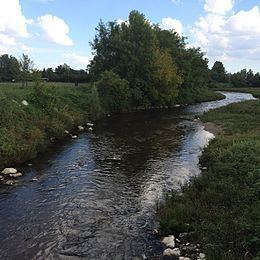Length 71 km | Basin size 1,038 km (401 sq mi) Discharge 14 m³/s | |
 | ||
Main source Principal source at Fornaci della Riana at 548 m (Rasa di Varese). Other springs are at Monte Martica (937 m), Passo Varrò (760 m), Alpe Ravetta (618 m), Pian Waldes (720 m) and Miniera Valvassera (450 m)548 m (1,798 ft) Similar | ||
The Olona (Ulona, Urona or Uòna in Western Lombard) is an Italian river, 71 kilometres (44 mi) long, that runs through the provinces of Varese, Milan and Pavia.
Contents
Map of Olona, Italy
The Olona has more than one source; in fact it has six main springs. Three springs are located in the Rasa Valley, just above Varese, whereas other three springs pour water down from the southern side of pleasant Valganna - since 1877 these still clean and fresh mountain waters were historically used, and still are, to make beer in a renowned local brewery, Poretti, now run by Carlsberg.
The Olona river passes through the deep Olona Valley, cut in the poruous soils of the upper Po Valley, eventually flowing in the plain after Legnano. It is in the Olona valley part that the river gets much of the industrial pollution which has made it a byname for venomous waters for decades. Only in recent years attempts to restore the river's ecology have proven at least partially successful. After Legnano, the Olona river flows in the plain until Milan, usually contained in narrow artificial banks. New expansion basins are being constructed to prevent floodings, which are rare but can be devastating under conditions of sudden intense rain in the upper river flow.
In ancient times, the 131-kilometre (81 mi) long Olona continued its course south of Milan, through the Province of Pavia, eventually joining the Po. Due to massive hydraulic works, that started in the Roman Age and were continued until the 20th century, just before Milan the river leaves its natural bed and begins to flow under the street level, like a sewer, feeding and becoming part of the complex groundwater system of the city.
Immediately after passing through a tunnel under the Naviglio Grande, the Olona flows into the Lambro Meridionale, that carries its waters in the Lambro. Until the late 1980s, a branch of the Olona fed the Darsena of Porta Ticinese (the inner harbour of Milan). The water flow in this branch was first reduced, and finally completely cleared, when city authorities realized that the river's pollution began to threaten the Darsena and the Naviglio Pavese, which originates from it.
The Olona river counts 39 tributaries. The principal tributaries are the torrents Vellone, Bevera Varesino, Lanza (or Gaggiolo), Bozzente, Lura, Merlata and Mussa.
"Southern" or "Lower" OlonaEdit
Also a stream, 41 kilometres (25 mi) long, that flows entirely within the province of Pavia is called "Olona". Some historical researches, supported by geographic and geological data, suggest that the bed of this river is nothing but the southernmost part of the ancient Olona, that the Romans diverted to Milan. This fact easily explains why the two rivers carry the same name.
This river originates from the join of many secondary watercourses in the country south of Milan, and receives also a notable amount of water from several natural springs ("fontanili"). Near San Zenone it flows into the Po.
Although it is usually indicated simply as Olona on topographic and road maps, it may be called either Olona inferiore (Lower Olona) or Olona meridionale (Southern Olona) for better distinction with the northern Olona.
